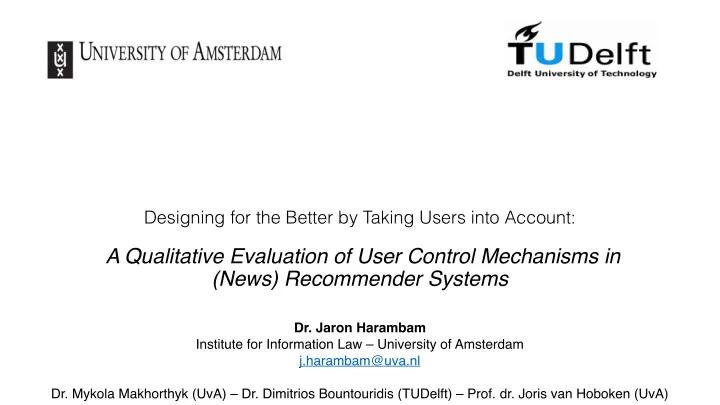

Designing for the Better by Taking Users into Account: A Qualitative Evaluation of User Control Mechanisms in (News) Recommender Systems Dr. Jaron Harambam Institute for Information Law – University of Amsterdam j.harambam@uva.nl Dr. Mykola Makhorthyk (UvA) – Dr. Dimitrios Bountouridis (TUDelft) – Prof. dr. Joris van Hoboken (UvA)
Recommender Systems: Curse or Blessing?
Concerns Filter bubble fears, or reduction of diversity Lack of transparency Little user control
Recommender systems in the news domain Legacy media corporations and social media platforms Greater controversy: Information is crucial to democracy
Fair News Project What are the ethical, societal and technical dimensions of the rise of recommender systems in the news domain?
Different Subprojects Ethnographic Research News Reader Research Simulation Model
News Reader Focus Groups Why focus on user control? Empirical argument Theoretical argument
Focus Groups User Control Study Four focus groups, or think-aloud sessions (N=21) RQ: how do people evaluate different control mechanisms in news RS? Collectively reviewed a News Recommender Prototype (NRP) Control mechanisms at input , process and output level
Focus Groups User Control Study Qualitative research design: Complexity and nuance in people’s own words Aimed at highlighting diversity: making distinct positions clear Quantitative studies can test these across broader populations
News Recommender Prototype (NRP)
News Recommender Prototype (NRP)
Results General observations: Distrust: who is being served here? Usefulness: only with much contents Intuitive design: inline with recommendations
Results Input level: Dashboard with reading history: self-realization Content categorization: flexible adjustments
Results Process level: Choosing different recommender algorithms: easy and powerful Anthropomorphized recommender algorithms: divergence
Results Output level: Ordering content: not really in “control” Nice extra, but not sufficient
Conclusion Strong desire for more control Aligns with current data protection regulations (GDPR) Reciprocity: meaningful return of personal data collected Self-Actualization: activating and achieving personal goals
Thank you for your attention RecSys 2019 Paper at ACM Digital Library: https://dl.acm.org/citation.cfm?id=3347014 Dr. Jaron Harambam Institute for Information Law – University of Amsterdam j.harambam@uva.nl
Recommend
More recommend